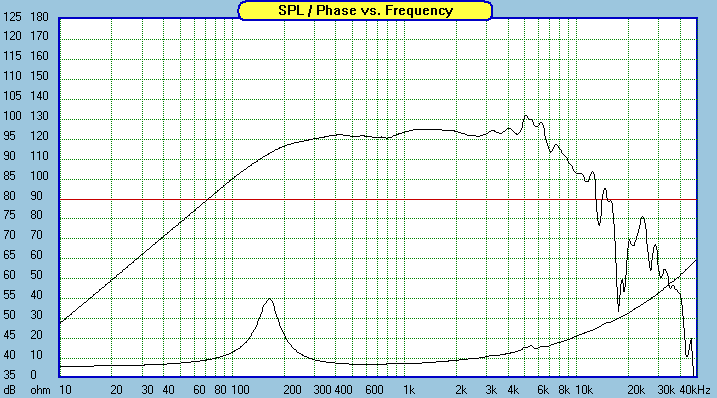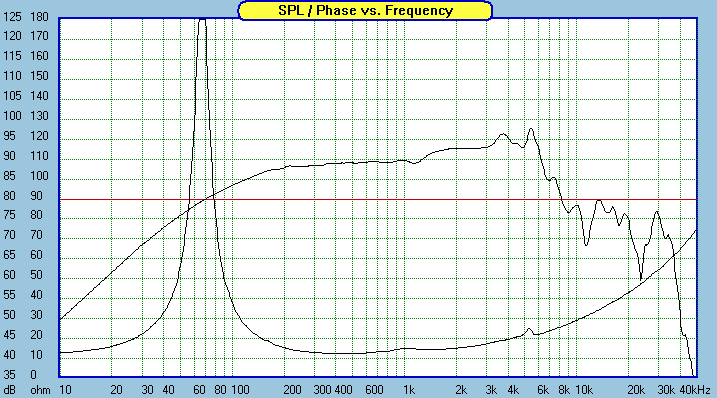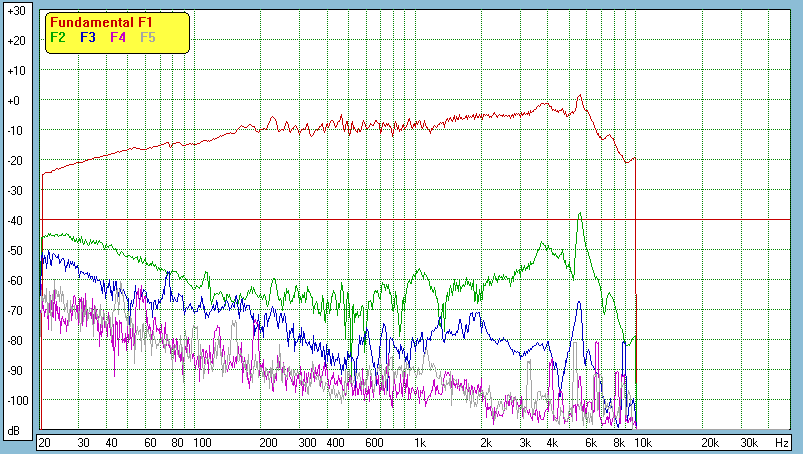Hi fb,
No, it's sealed but I might consider aperiodically vented alternative. In the active system with active subwoofers varioventing may provide slight improvement if cut off frequency is low. Bass reflex contributions of the main speakers are of course outside of the range when subwoofers are employed. Sealed enclosures are the easiest to control. My boxes at the moment weight about 35kg each but I may try to fill their bottoms with some sand.
I did not know that Rythmik Audio products were available in Australia. I am after the 15" servo system - driver plus amplifier with the servo system. The amp could come without PS as I would replace the standard one with my own anyway. Do they (Brisbane distributors) sell complete kits or just individual drivers?
cheers,
No, it's sealed but I might consider aperiodically vented alternative. In the active system with active subwoofers varioventing may provide slight improvement if cut off frequency is low. Bass reflex contributions of the main speakers are of course outside of the range when subwoofers are employed. Sealed enclosures are the easiest to control. My boxes at the moment weight about 35kg each but I may try to fill their bottoms with some sand.
I did not know that Rythmik Audio products were available in Australia. I am after the 15" servo system - driver plus amplifier with the servo system. The amp could come without PS as I would replace the standard one with my own anyway. Do they (Brisbane distributors) sell complete kits or just individual drivers?
cheers,
Oh sorry, my comment about the brisbane place was for the 18sound products - I got my 12" servo system direct from rythmik audio - postage was reasonable as far as I remember.
I looked into doing a 2way + sub with the 6nd430, but it's too excursion limited for sealed, and the rise in group delay a bit too high in frequency for vented.
I looked into doing a 2way + sub with the 6nd430, but it's too excursion limited for sealed, and the rise in group delay a bit too high in frequency for vented.
If I might interject my usual blashphemy about distortion, you guys are putting way too much emphasis on THD. No one in the Pro world believe that THD is in any way an indicator of sound quality. It's simply not related to anything that we hear.
I have used the B&C 6" drivers and they are quite good. I've disassembled them and the build is good and reliability of B&C is always good. You can rely on their measurements as they are usually quite accurate. I have seen 18-sound data to be quite variable from the spec sheets.
I have used the B&C 6" drivers and they are quite good. I've disassembled them and the build is good and reliability of B&C is always good. You can rely on their measurements as they are usually quite accurate. I have seen 18-sound data to be quite variable from the spec sheets.
🙂
I certainly don't have the experience to know whether distortion matters that much. I have heard however quite a variety of outdoor pa rigs that with rare exceptions (a Funktion 1 rig) have always been some degree of ear shredding. I'm not sure if that's distortion at work? Zaph's review's at least can give me some confidence in the quality of the driver.
FWIW the best sounding speaker I've heard is an Ekta Grand (design by Troels Gravesen) that used all low distortion drivers.
What factors would you look for in identifying a quality driver? What do you mean by 18sound data being variable?
Cheers

I certainly don't have the experience to know whether distortion matters that much. I have heard however quite a variety of outdoor pa rigs that with rare exceptions (a Funktion 1 rig) have always been some degree of ear shredding. I'm not sure if that's distortion at work? Zaph's review's at least can give me some confidence in the quality of the driver.
FWIW the best sounding speaker I've heard is an Ekta Grand (design by Troels Gravesen) that used all low distortion drivers.
What factors would you look for in identifying a quality driver? What do you mean by 18sound data being variable?
Cheers

I measured a purchase of 18Sound drivers some years back at a clients and they didn't match the specs. He sent them back. Thats all I know.
PAs with horns have serious objectionable flaw in the horns caused by diffractions and resonances. This is not distortion in the sense of harmonic distortion. We did a test of compression drivers and found that subjects (blind) could not hear THD at 25% in the drivers themselves. The horns add only low order THD and not that significant anyways. But the diffraction, etc. becomes quite objectionable at higher levels - we showed this in another study.
I just ignore the THD numbers, but do look very carefully at the frequency response and resonances as these are hard to design around and usually define the end resulting quality far more than any THD number will. I then rely more on a teardown of the drivers to see the build quality and design. Never use a driver without a shorting ring if its going to be wide band. This kind of distortion is audible, but fairly easily corrected with a shorting ring or copper pole piece cap. Many of the B&C's have this.
PAs with horns have serious objectionable flaw in the horns caused by diffractions and resonances. This is not distortion in the sense of harmonic distortion. We did a test of compression drivers and found that subjects (blind) could not hear THD at 25% in the drivers themselves. The horns add only low order THD and not that significant anyways. But the diffraction, etc. becomes quite objectionable at higher levels - we showed this in another study.
I just ignore the THD numbers, but do look very carefully at the frequency response and resonances as these are hard to design around and usually define the end resulting quality far more than any THD number will. I then rely more on a teardown of the drivers to see the build quality and design. Never use a driver without a shorting ring if its going to be wide band. This kind of distortion is audible, but fairly easily corrected with a shorting ring or copper pole piece cap. Many of the B&C's have this.
Thanks for replying. I had a quick read of your Summa white paper.
What is available in terms of 'oblate spheroidal' waveguides?
I notice you use the DE250, what advantage does this have over the DE10?
Your paper mentions small rooms, will such a speaker still sound good outdoors/in a large room?
What is available in terms of 'oblate spheroidal' waveguides?
I notice you use the DE250, what advantage does this have over the DE10?
Your paper mentions small rooms, will such a speaker still sound good outdoors/in a large room?
My offereings of waveguides are listed on my site.
The DE250 has a lot more power capability and some sensitivity, thats about all, but these are important differences. The woofer in the Summa is rated at 1400 Watts. The DE10 won't keep up with that, the DE250 just does.
Outdoors and big rooms are easy. If something works good in a small room - and has enough power, thats usualy the limitation - then it will work good in the easier venues. There are several night clubs in Bangkok using these systems. They like them very much. These speakers blast sound if desired.
The DE250 has a lot more power capability and some sensitivity, thats about all, but these are important differences. The woofer in the Summa is rated at 1400 Watts. The DE10 won't keep up with that, the DE250 just does.
Outdoors and big rooms are easy. If something works good in a small room - and has enough power, thats usualy the limitation - then it will work good in the easier venues. There are several night clubs in Bangkok using these systems. They like them very much. These speakers blast sound if desired.
Ged,
I think your comments are misleading to beginners. Clearly non-linear distortion matters to you- you choose larger drivers and those with shorting rings for your Summa kits because it matters to you.
For the user who doesn't want to disassmble drivers to check the design and build quality, measurements like Zaph's are extremely useful. Perhaps you are unfamiliar with the large proportion of commonly available "hi-fi" drivers, because most of them do not use copper shorting rings (standard SEAS range, nearly all Vifa, majority of Peerless, Morel, Eton, Dynaudio) and even if those that do (ScanSpeak, SEAS Excel, Usher, Dayton RS), not all are implemented the same, or result in the same distortion spectra.
There are many commercial hi-fi brands that still state "THD" in their speaker marketting literature. I think most of us know that relying on these numbers to judge a speaker's sound is a waste of time.
I don't think Zaph's or anyone here mentioned the THD word or figure anywhere in their measurements or discussion. Everyone is talking about non-linear distortion spectra.
You are preaching to the converted.
Without the shorting ring, the 18sound driver (and your B&C drivers) would have the odd order harmonic distortion raised by some 10dB, and that is audible...
You are arguing, but you are agreeing.
I think your comments are misleading to beginners. Clearly non-linear distortion matters to you- you choose larger drivers and those with shorting rings for your Summa kits because it matters to you.
For the user who doesn't want to disassmble drivers to check the design and build quality, measurements like Zaph's are extremely useful. Perhaps you are unfamiliar with the large proportion of commonly available "hi-fi" drivers, because most of them do not use copper shorting rings (standard SEAS range, nearly all Vifa, majority of Peerless, Morel, Eton, Dynaudio) and even if those that do (ScanSpeak, SEAS Excel, Usher, Dayton RS), not all are implemented the same, or result in the same distortion spectra.
There are many commercial hi-fi brands that still state "THD" in their speaker marketting literature. I think most of us know that relying on these numbers to judge a speaker's sound is a waste of time.
I don't think Zaph's or anyone here mentioned the THD word or figure anywhere in their measurements or discussion. Everyone is talking about non-linear distortion spectra.
You are preaching to the converted.
Without the shorting ring, the 18sound driver (and your B&C drivers) would have the odd order harmonic distortion raised by some 10dB, and that is audible...
You are arguing, but you are agreeing.
I guess that I should have said that people were putting too much emphasis on second and third harmonics - I don't consider these important at all. I think that my point is that second and third harmonic "spectra" are not any more instructive than THD. As far as nonlinearity goes, the only one I ever consider is the inductance, never the displacement related nonlinearities. I use larger drivers for directivity and thermal performance, NOT nonlinearity, although, admittedly, this does make the displacement nonlinearity insignificant.
But if you agree with all this then great!
But if you agree with all this then great!
Hi,
which driver would you pick for a 3 way system :
PHL 1120
B&C 6MD38
B&C 6NDL38
18sound 6ND430
With 12" doing 40-300hz, 6" doing 300-2000 and 1 or 1 1/4 tweeter
Greg
which driver would you pick for a 3 way system :
PHL 1120
B&C 6MD38
B&C 6NDL38
18sound 6ND430
With 12" doing 40-300hz, 6" doing 300-2000 and 1 or 1 1/4 tweeter
Greg
Last edited:
6MD38 plus 12" plus 1" CD + WGHi,
which driver would you pick for a 3 way system :
PHL 1120
B&C 6MD38
B&C 6NDL38
18sound 6ND430
With 12" doing 40-300hz, 6" doing 300-2000 and 1 or 1 1/4 tweeter
Greg
6MD38 seems very nice and is quite a bargain.
The Peerless HDS in a waveguide would be a good match :
http://www.htguide.com/forum/showth...-testing-(dome-tweeters)&highlight=waveguides
6MD38 :


18sound :


The Peerless HDS in a waveguide would be a good match :
http://www.htguide.com/forum/showth...-testing-(dome-tweeters)&highlight=waveguides
6MD38 :
This is a dedicated midrange and as such it's bass extension and performance are not part of these ratings, though +/- 2mm extends low end usability over many other dedicated midranges. It is a very sensitive pro driver with a cast frame and cloth accordian surround. Relatively smooth response curve with a mild breakup at 5kHz. Very clean lower midrange with a usable upper midrange. A solid 96dB at 8 ohms. If you need that kind of sensitivity in an 8 ohm midrange, this is a good driver for that purpose. Tested August 2008.


18sound :
Excellent performing 16 ohm pro midwoofer. Smooth response and an extremely clean midrange. Very usable T/S parameters and excursion though somewhat limited bass extension for what is meant for woofer service. Very sensitive. It would make a fine midrange also. Lightweight neo magnet assembly with cooling fins. A couple of these paired up for an MTM and used with a subwoofer would make a reference level system. High value for this level of performance. Tested August 2008.


6MD38 seems very nice and is quite a bargain.
The Peerless HDS in a waveguide would be a good match :
http://www.htguide.com/forum/showth...-testing-(dome-tweeters)&highlight=waveguides
B&C 6MD38 :


18sound 6ND430-16:


even if H3=H2 for the 6MD38 you have 50db of attenuation which seems fine.
Some speakers including the expensive Scan-Speak 18WU8741T00 behave the same way.
Greg.
The Peerless HDS in a waveguide would be a good match :
http://www.htguide.com/forum/showth...-testing-(dome-tweeters)&highlight=waveguides
B&C 6MD38 :
This is a dedicated midrange and as such it's bass extension and performance are not part of these ratings, though +/- 2mm extends low end usability over many other dedicated midranges. It is a very sensitive pro driver with a cast frame and cloth accordian surround. Relatively smooth response curve with a mild breakup at 5kHz. Very clean lower midrange with a usable upper midrange. A solid 96dB at 8 ohms. If you need that kind of sensitivity in an 8 ohm midrange, this is a good driver for that purpose. Tested August 2008.


18sound 6ND430-16:
Excellent performing 16 ohm pro midwoofer. Smooth response and an extremely clean midrange. Very usable T/S parameters and excursion though somewhat limited bass extension for what is meant for woofer service. Very sensitive. It would make a fine midrange also. Lightweight neo magnet assembly with cooling fins. A couple of these paired up for an MTM and used with a subwoofer would make a reference level system. High value for this level of performance. Tested August 2008.


even if H3=H2 for the 6MD38 you have 50db of attenuation which seems fine.
Some speakers including the expensive Scan-Speak 18WU8741T00 behave the same way.
Greg.
I agree. I've been eyeing a pair for ages to add to the JBL 2225 and 18Sound ND1090 + Ewave WG to make an active speaker. But I don't have an actual use for it at the moment, just most of the parts.6MD38 seems very nice and is quite a bargain.
In one of my three way systems plus active sub I use pairs of 18sound 6nd430 (2x16ohm) working up to 800Hz. I would not use them above 1kHz. They are pretty good but should not be used below 200Hz and certainly below 150Hz. As subs do not really go above 120-150Hz these are not best choice for such systems. As you plan to cut them at 300Hz so it's OK.
I understand that your 12" is not a sub. Nevertheless, I favour most subs working up to about 100Hz and above that a pair of 8" drivers works best in most cases. If one needs them to go down to say 70-80Hz then a pair of 10" drivers is best. The upper cut off frequency should be then about 600-800Hz.
cheers,
I understand that your 12" is not a sub. Nevertheless, I favour most subs working up to about 100Hz and above that a pair of 8" drivers works best in most cases. If one needs them to go down to say 70-80Hz then a pair of 10" drivers is best. The upper cut off frequency should be then about 600-800Hz.
cheers,
More data for you guys. I figure you can never have too much data.
For the B&C 6MD38 http://www.prodance.cz/protokoly/6MD38.pdf
For the B&C 6MD38 http://www.prodance.cz/protokoly/6MD38.pdf
- Status
- Not open for further replies.
- Home
- Loudspeakers
- Multi-Way
- 18sound 6ND430 - Zaph tested

